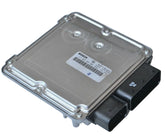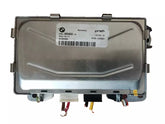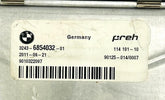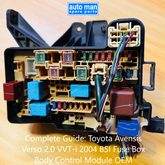Choosing a reliable used steering control unit can save money while restoring safe steering response. This guide explains sourcing, compatibility checks, and installation steps for US car owners and small shops.
TL;DR / Key takeaways
-
Replacing a faulty used steering control unit (SCU) can restore power steering; compatibility and firmware matching are critical.
-
Expect used SCUs to cost roughly $35–$50 in junkyards historically; reputable resellers may offer 30–90 day warranties.
-
Mismatched firmware or variant parts can cause system failure; always verify part numbers, firmware versions, and VIN compatibility.
-
Sourcing options: junkyards, tested resellers, and online marketplaces — each has trade-offs in inspection, warranty, and returns.
-
After install, test thoroughly and consider replacing related sensors and harnesses to ensure reliability.
Section 1: Introduction to used steering control units
Summary: A steering control unit is the electronic brain for steering assist and stability functions.
What is a steering control unit (SCU)?
An SCU coordinates signals among steering sensors, the actuator, and vehicle controls. It reads torque and angle sensors, commands the assist motor, and shares data with stability systems. One-sentence definition: An SCU is the electronic module that controls steering assist and communicates steering status to other vehicle modules.
Why people consider used SCUs
Buyers choose used SCUs to save money or to source rare modules for older models. Examples include classic cars or discontinued OEM modules. Used parts often cost a fraction of new OEM modules but require verification.
Important caveat
Modern cars often demand firmware alignment across modules; mismatches can trigger safety faults. If you cannot confirm firmware or module history, do not install the unit.
Section 2: How to source used steering control units in the US
Summary: You can source used SCUs from junkyards, tested resellers, or marketplaces — each option has pros and cons.
Sourcing options
-
Junkyards / salvage yards: Lowest price, variable testing.
-
Reputable parts resellers: Higher cost, documented testing and short warranties. (See an example of a tested catalog at Automan Spare Parts.) Automan Spare Parts catalog
-
Online marketplaces: Wide selection; verify seller testing and return policy.
What to inspect or verify before buying
Start by confirming part numbers and VIN compatibility. Ask for firmware/version info and any functional test results. Inspect for corrosion, water damage, bent pins, or burned components. Request a short-term warranty (30–90 days) and testing documentation when possible.
Quick scouting tips
Request donor vehicle details and mileage. Check recalls and service bulletins at NHTSA to flag units affected by safety actions. NHTSA recalls
Practical cost expectations
Historically, junkyard SCUs in the US ranged around $35–$50. Resellers charge more but may include bench testing and limited warranties.
Section 3: Compatibility and installation considerations
Summary: Verify part numbers, firmware, and related components before installation to avoid failures.
How to verify compatibility
Step 1: Confirm the exact part number on your current SCU and the donor unit. Step 2: Run a VIN-to-part lookup or ask the seller for vehicle-match verification. Step 3: Verify firmware versions for models that require uniform versions. Step 4: Identify sensors or harnesses that may need replacement.
Firmware and model-year considerations
Firmware matching matters for many modern systems; mismatched versions can prevent adaptations or cause warning lights. Some cars require dealer-level reprogramming.
Installation basics (high level)
Disconnect the battery before removal. Replace damaged connectors and seals. After installation, clear codes and perform calibrations per service instructions. Do not skip post-install adaptations and live-data checks.
When you should not install a used SCU
Do not install if firmware is unknown, the donor unit shows damage, or the unit lacks test documentation. Avoid used units when regulations or safety concerns require known-new modules.
Section 4: Diagnosis & common issues to watch for
Summary: Recognize failing SCU symptoms early and run focused diagnostics.
Warning signs your SCU might be failing
Look for erratic assist, stiff steering, loss of power assist, and steering-related dashboard lights. DTCs referencing steering, torque sensor, or communication errors often point to the SCU.
How to test (high-level)
Use an OBD2 scanner that reads module-specific codes and live data. Check steering angle, torque sensor values, and motor current traces. If live data is absent or inconsistent, the SCU may be faulty.
Safety considerations
Driving with a suspect SCU can be dangerous. If uncertain, stop driving and seek professional diagnosis.
Section 5: Maintenance, upgrades, and what to replace with a used unit
Summary: Replace related sensors and verify electrical health when installing a used SCU.
What to replace or inspect during installation
Inspect steering angle sensors, torque sensors, connectors, wiring harnesses, and battery ground points. Replace worn sensors and corroded connectors for reliable operation.
Could upgrading improve safety or performance?
A newer used unit with updated firmware can improve reliability if fully compatible. Upgrading only makes sense when firmware and wiring match the vehicle’s ecosystem.
Post-installation maintenance tips
Run a complete diagnostic after install, monitor the system for the first 300–500 miles, and re-check for software updates or recalls.
Section 6: Cost, value, and risk considerations
Summary: Balance price savings against compatibility risk and potential hidden failures.
Typical cost ranges
Junkyard: ~$35–$50 historically. Reseller: higher, varies by model and testing. Refurbished units cost more but usually include testing and a warranty.
Value vs. risk
Pros: cost savings and quick repairs. Cons: potential firmware mismatch, hidden damage, or no warranty. Cheaper units can be false economy if they fail quickly.
Lifespan expectations
A used SCU may last years or fail soon depending on prior use and environmental damage. Refurbished units usually offer longer life expectancy.
Section 7: Real-life use cases and examples
Summary: Examples show successful swaps when compatibility and testing are verified.
Case 1: Nissan 300ZX HICAS restoration
A tested donor unit with matching model numbers restored HICAS function after correct installation and calibration.
Case 2: GM Volt power steering control module replacement
Diagnosis identified torque/angle signal issues; technicians verified firmware and reprogrammed the module to restore assist.
Case 3: MR2 Spyder endurance race adaptation
A used electric steering module was selected for durability, then calibrated to match race steering dynamics.
Section 8: FAQ (quick answers)
Q: Where can I buy reliable used SCUs in the US?
Junkyards, reputable tested resellers, and trusted online sellers; always verify part numbers, firmware, and return policies.
Q: How do I verify a junkyard SCU is in good working order?
Check part numbers, donor vehicle details, ask for testing history, inspect for water damage, and request a short warranty.
Q: Can I install a SCU from a different model or year?
Only if part numbers and firmware versions match and the seller confirms VIN compatibility.
Q: What are the signs of a failing SCU?
Loss of power assist, erratic steering, warning lights, and SCU-related DTCs.
Q: Should I upgrade to a newer SCU?
Consider upgrades only when firmware and wiring are compatible and the benefits justify cost.
Q: What maintenance after installation is required?
Run diagnostics, perform calibrations, and monitor steering behavior for several hundred miles.
Section 9: Real-world sourcing landscape snapshot (context from current market)
Summary: The market favors tested, in-stock units with clear shipping and return policies.
Example supplier context
Some sellers, like Automan Spare Parts, emphasize testing, US delivery, and clear return terms for steering control units. Their catalog shows a market trend toward tested and warrantied used units. Automan Spare Parts
Practical takeaway for buyers
Favor suppliers who provide testing statements, compatibility checks, and warranties. Expect complex systems to need precise firmware matching and professional reprogramming.
Section 10: Checklists, tables, and quick-reference resources
Summary: Use a concise checklist before buying and a small comparison table to choose a source.
Quick buyer checklist
-
Confirm exact part number and VIN compatibility
-
Verify firmware requirements across critical modules
-
Inspect for water and corrosion damage
-
Ask for test documentation and warranty terms
-
Review return policy and shipping details
Comparison highlights
-
Junkyard: low cost, variable testing, higher risk
-
Reseller: documented testing, warranty, higher cost
-
Marketplaces: broad selection; vet sellers carefully
Final summary
Choosing a reliable used steering control unit requires careful checks of part numbers, firmware, and physical condition. Sourcing from a tested reseller reduces risk, while junkyards offer low cost but higher uncertainty. After installation, run diagnostics and monitor performance closely for safety.
References and resources
-
NHTSA recalls and safety info: https://www.nhtsa.gov/recalls
-
Example tested catalog: https://automanspareparts.com/collections/steering-control-unit
-
Consumer buying guidance: https://www.edmunds.com







